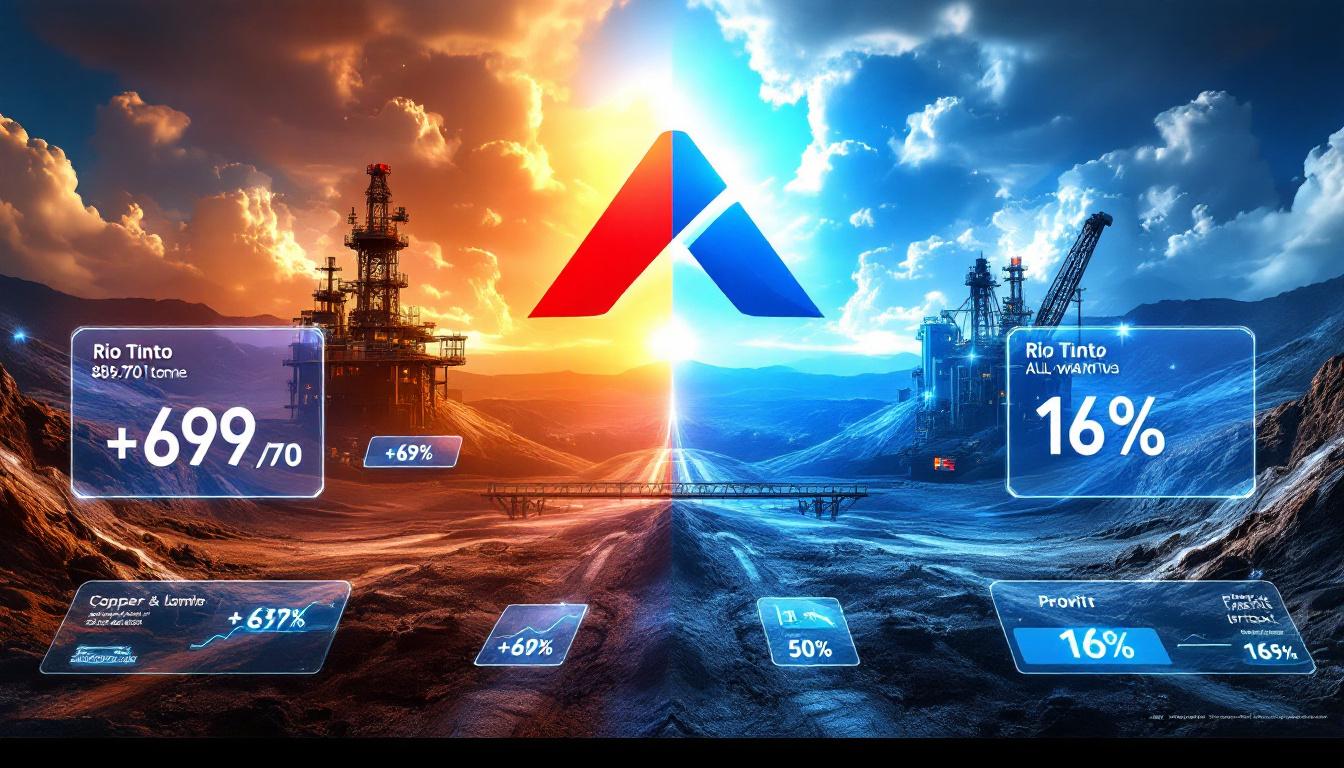Why Are Commodity Traders Launching Mining Finance Funds?
In a significant strategic shift, major commodity traders are increasingly establishing specialized mining finance funds, positioning themselves at the intersection of capital markets and physical commodities. This trend reflects growing recognition of critical supply constraints and the competitive advantages of securing long-term metal supply contracts in an increasingly resource-constrained world.
The recent partnership between Vitol Group and Breakwall Capital exemplifies this emerging pattern. Their joint venture, Valor Mining Credit Partners LP, targets mining companies operating throughout the Americas, providing a clear indication that trading giants' focus is no longer content with traditional trading models alone.
"We see a tremendous opportunity to bridge an unmet need in the marketplace," stated Breakwall's managing partners, highlighting the strategic rationale behind this emerging trend. This sentiment encapsulates why commodity traders are evolving their business models toward more integrated supply chain participation.
How Is Competition for Metal Supply Contracts Intensifying?
The battle for future metal supply contracts has intensified dramatically as global demand projections for critical minerals continue to outpace supply expansion. This competition is particularly fierce for copper – the metal most explicitly mentioned in Vitol's strategic focus – which faces projected supply deficits amid booming demand from electrification and renewable energy infrastructure.
Commodity traders traditionally operated as intermediaries, connecting producers with end users while capturing margins on logistics, timing, and market inefficiencies. Today's landscape demands more proactive approaches, with financing increasingly becoming the preferred method for securing privileged access to physical supply.
"Traders have long provided companies with upfront capital to help finish projects, often in return for future supply," notes industry analysis from Bloomberg. "That's fast becoming a go-to way of locking in supply contracts as competition among traders for copper and other metals contracts heats up."
This financing-for-supply approach represents a fundamental evolution in how commodity traders position themselves within global supply chains – shifting from pure intermediaries to strategic capital providers with privileged access to physical production.
What Is Vitol's New Mining Finance Fund?
Vitol Group, one of the world's largest independent energy traders with annual revenue exceeding $270 billion, has formed Valor Mining Credit Partners LP in partnership with Breakwall Capital. This represents a strategic expansion beyond Vitol's traditional energy focus into the increasingly critical energy transition metals sector.
Partnership Structure and Management
The fund establishes a clear division of responsibilities: Breakwall Capital, which spun out from Riverstone Credit Partners in 2024, will manage the fund's operations, while Vitol provides significant financial resources and commodity market expertise. This structure leverages complementary strengths – Breakwall's credit analysis capabilities and Vitol's deep understanding of physical commodity markets.
This isn't Vitol's first venture with Breakwall. The companies have previously collaborated on an upstream oil and gas fund, demonstrating Vitol's methodical approach to expanding its investment portfolio across related commodity sectors.
Investment Focus and Geographic Scope
Valor Mining Credit Partners LP has established a clear mandate focusing on mining operations throughout the Americas. The fund will provide capital specifically targeting:
- Debt refinancing opportunities: Helping miners restructure existing obligations
- Strategic acquisitions: Funding consolidation and growth
- Operational expansions: Supporting increased production at existing sites
- Project development initiatives: Accelerating new production capacity
This regional focus allows Vitol to strengthen its position in mineral-rich jurisdictions throughout North and South America while managing geopolitical risk through geographic diversification within a single continental framework.
How Does This Fund Address Current Market Gaps?
Mining Industry's Financing Challenges
The mining sector currently faces an acute financing crunch, with traditional capital sources retreating from the industry despite growing demand for minerals. According to the transcript, "Mining companies are on the lookout for more funds as banks and equity markets continue to be wary of investing into the sector."
This financing gap creates significant challenges for mining companies, including:
- Difficulty securing development capital for new projects
- Limited options for refinancing existing debt
- Constrained ability to pursue strategic acquisitions
- Slower capacity expansion despite strong demand fundamentals
These challenges are particularly acute for mid-tier producers and developers – companies too large for venture funding but too small to easily access corporate bond markets or secure traditional bank financing.
Trader-Led Financing Solutions
Commodity traders like Vitol are uniquely positioned to address these market gaps through specialized financing vehicles. Their approach offers several distinct advantages:
- Industry-specific expertise: Traders understand commodity market dynamics and can assess project viability through a practical commercial lens
- Supply chain integration: Financing can be structured alongside offtake agreements, creating aligned incentives
- Flexible capital deployment: Funds can be tailored to specific project needs rather than standard banking templates
- Competitive terms: Financing can potentially offer more favorable terms than traditional lenders, reflecting the strategic value of supply agreements
For mining companies, these trader-led solutions represent a vital alternative capital source when traditional options are unavailable or prohibitively expensive. For traders like Vitol, they represent an opportunity to secure privileged access to physical commodities while generating returns on deployed capital.
What's Driving Trader Interest in Mining Finance?
Redeployment of Energy Trading Profits
Major commodity traders including Vitol, Mercuria Energy Group Ltd, and Trafigura have accumulated substantial profits from their energy trading operations in recent years. According to the transcript, these companies are now strategically "allocating large energy trading profits into a slice of the increasingly volatile metal markets."
This redeployment strategy serves multiple strategic objectives:
- Portfolio diversification: Reducing reliance on traditional energy markets
- Growth opportunities: Positioning for expanding metals demand
- Strategic positioning: Securing competitive advantages in critical minerals
- Margin enhancement: Capturing additional value chain segments beyond trading
The energy transition creates natural synergies between traders' historical expertise in oil markets and their growing interest in metals. As transportation electrifies and renewable energy expands, traders can leverage existing client relationships while pivoting toward the materials enabling this transformation.
Strategic Advantages of Supply Contracts
For commodity traders, providing financing in exchange for future supply offers several crucial strategic benefits that extend beyond simple investment returns:
- Physical commodity access: Guaranteed volumes in potentially tight markets
- Trading position enhancement: Improved market intelligence and position management
- Customer service capabilities: Ability to reliably service end-user requirements
- Risk mitigation: Reduced exposure to price spikes and supply disruptions
- Margin stacking: Potential to capture both financing returns and trading margins
This approach represents a sophisticated evolution of traditional trading models, with financing becoming an integral tool for securing competitive advantage rather than merely a supplementary business line.
"Traders meanwhile have long provided the companies with upfront capital to help finish projects, often in return for future supply. That's fast becoming a go-to way of locking in supply contracts as competition among traders for copper and other metals contracts heats up."
Which Metals Are Traders Most Interested In Securing?
Critical Minerals in High Demand
While Vitol's fund doesn't explicitly limit its focus to specific metals, market conditions and the transcript's specific mention of "copper and other metals" provides clear direction on priority targets. Copper stands as the most strategically significant metal for traders, functioning as both an industrial staple and a critical component in energy transition technologies.
Beyond copper, trader interest likely extends to:
- Battery metals: Lithium, cobalt, and nickel – essential for energy storage
- Rare earth elements: Critical for permanent magnets in wind turbines and EV motors
- Aluminum: Key for lightweight transportation and renewable infrastructure
- Zinc and lead: Industrial staples facing potential supply constraints
The common thread connecting these metals is their essential role in energy transition technologies coupled with concentrated supply chains vulnerable to disruption.
Supply-Demand Dynamics Driving Interest
Several structural factors are creating particularly favorable conditions for trader financing in the metals sector:
- Extended development timelines: New mines typically require 7-10 years from discovery to production
- Capital intensity: Modern mining projects often require billions in development capital
- Concentrated production: Many critical minerals face geographic production concentration
- Technology-driven demand growth: Accelerating adoption of electric vehicles and renewable energy
- Declining ore grades: Requiring more capital-intensive processing for the same output
These factors collectively contribute to projected supply deficits that increase the strategic value of secured offtake agreements – precisely what trader financing aims to achieve.
How Are Mining Companies Responding to These Financing Options?
Benefits for Mining Operators
For mining companies, trader financing offers several distinct advantages compared to traditional funding sources:
- Access to capital: Alternative funding when conventional options are limited
- Industry understanding: Traders comprehend commodity price cyclicality
- Streamlined process: Potentially faster approval than traditional project finance
- Operational flexibility: Structures that accommodate mining's inherent uncertainties
- Market intelligence: Traders provide valuable insights on end-user demand trends
According to the transcript, mining companies are actively "on the lookout for more funds" as traditional sources remain hesitant, suggesting receptiveness to these alternative financing arrangements.
Potential Considerations and Risks
Mining companies must carefully evaluate these arrangements against several potential drawbacks:
- Supply commitment duration: Long-term offtake agreements may limit future optionality
- Pricing mechanisms: Ensuring fair value for production over extended timeframes
- Counterparty concentration: Dependence on specific trading partners
- Flexibility limitations: Potential restrictions on production or marketing decisions
- Complex documentation: Sophisticated legal structures requiring specialized review
The optimal balance depends on individual company circumstances, project stage, and available alternatives. For some, trader financing represents an ideal solution; for others, it may introduce unacceptable constraints despite capital availability.
What Are the Market Implications of Increased Trader Financing?
Impact on Metal Markets
The growing involvement of traders in mining finance could influence market dynamics in several significant ways:
- Accelerated project development: Potentially bringing new supply online faster
- Enhanced market transparency: Traders' visibility across supply chains improves information flow
- Supply chain stabilization: Long-term agreements provide production certainty
- Changed price discovery: Larger percentages of production under long-term contracts
- Market concentration effects: Potential for traders to control significant supply portions
While increased trader financing may initially accelerate supply growth, the resulting offtake agreements could paradoxically reduce "free market" volumes available for spot trading, potentially increasing rather than decreasing price volatility.
Competitive Landscape Among Traders
As more traders enter the mining finance space, competition is intensifying across several dimensions:
- Geographic specialization: Traders developing regional expertise and relationships
- Metal-specific strategies: Focusing on particular commodity segments
- Financing structure innovation: Creating more sophisticated funding arrangements
- Technical capability development: Building mining-specific expertise
- Partnership approaches: Collaborating with specialized mining finance firms
This competitive dynamic benefits mining companies through improved financing terms while potentially squeezing returns for traders unless they can develop sustainable competitive advantages.
What Future Developments Can We Expect?
Potential Evolution of Trader Financing Models
As this trend matures, we may see several evolutionary developments:
- Specialized metal funds: Dedicated vehicles for specific commodities
- Direct ownership stakes: Equity participation alongside debt financing
- Technical service integration: Operational support beyond pure financing
- Downstream integration: Connecting producers with end-users through integrated supply chains
- ESG-linked structures: Financing tied to sustainability performance metrics
The line between trading and mining may continue to blur, with traders developing quasi-producer capabilities while maintaining their traditional intermediary functions.
Regulatory and ESG Considerations
Future developments will likely be shaped by increasing regulatory focus on:
- Supply chain transparency: Requirements for documenting mineral origins
- Environmental performance standards: More stringent operational requirements
- Social impact considerations: Growing emphasis on community relationships
- Governance standards: Enhanced disclosure and anti-corruption measures
- Climate alignment: Carbon footprint reduction throughout mineral supply chains
Traders that proactively address these factors in their financing structures will likely secure competitive advantages as regulatory requirements and customer expectations continue to evolve.
FAQs About Commodity Trader Mining Finance
How do mining finance funds differ from traditional mining investment?
Mining finance funds typically focus on providing debt capital rather than equity investment, often structured alongside offtake agreements rather than pure ownership stakes. This approach allows traders to secure physical commodity access while limiting direct operational involvement and liability exposure.
Traditional investments focus primarily on financial returns, while trader financing balances financial performance with strategic supply chain objectives. This dual purpose often results in more flexible terms than pure financial investors might offer, particularly regarding project timelines and development uncertainties.
What types of mining projects are most attractive to trader financing?
Traders typically prefer projects with:
- Near-term production potential: Revenue generation within 1-3 years
- Established resources: Proven geological understanding
- Clear development pathways: Well-defined engineering and permitting
- Experienced management: Demonstrated operational capabilities
- Products aligned with trading portfolios: Familiar commodities and specifications
Advanced exploration and expansion projects often present ideal opportunities – developed enough to have clear timelines but still requiring capital for completion.
How might these financing trends affect metal prices?
By facilitating new production capacity, trader financing could help moderate price increases in tight markets. However, by enabling traders to secure larger portions of production through offtake agreements, it might also contribute to market concentration.
The net effect depends on whether capacity expansion outpaces demand growth and what percentage of total production becomes committed to specific traders rather than available to the broader market. These dynamics vary significantly by metal and will likely evolve as the mining industry evolution matures.
What role does ESG performance play in trader financing decisions?
As ESG considerations become increasingly important throughout supply chains, traders are incorporating environmental and social performance criteria into their financing decisions. This integration serves multiple purposes:
- Reputation management: Avoiding association with controversial projects
- Customer requirements: Meeting end-user expectations for responsible sourcing
- Regulatory compliance: Adhering to evolving supply chain due diligence requirements
- Risk mitigation: Recognizing that poor ESG performance threatens project viability
- Impact measurement: Demonstrating positive developmental contributions
Projects with strong ESG credentials often secure more favorable financing terms, reflecting their lower risk profile and strategic alignment with evolving market expectations. For investors looking to understand these dynamics better, reviewing an ETCs investment guide and understanding investment strategy components can provide valuable context.
Disclaimer: This analysis is based on current market trends and publicly available information. Actual developments may differ significantly from these projections. Investors should conduct their own due diligence before making investment decisions related to mining companies or commodity markets.
Looking for Early Alerts on Major Mining Discoveries?
Discovery Alert's proprietary Discovery IQ model provides real-time notifications when significant mineral discoveries are announced on the ASX, giving traders and investors crucial early insights. Explore how these discoveries can generate substantial returns by visiting our dedicated discoveries page and position yourself ahead of the market.




